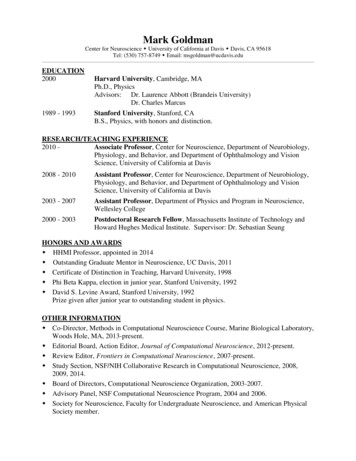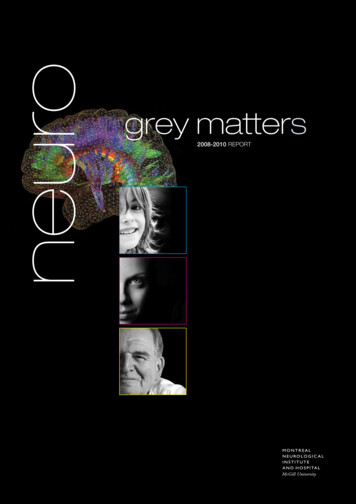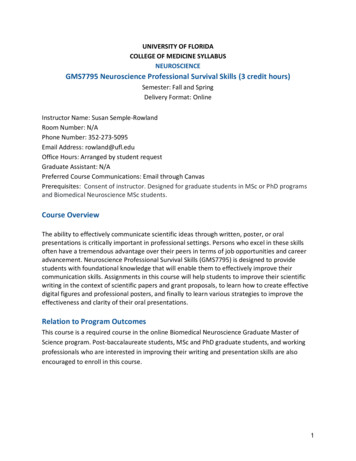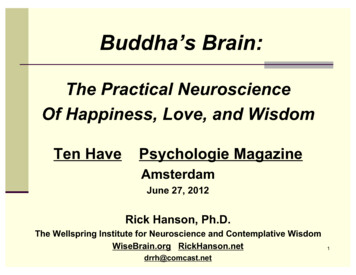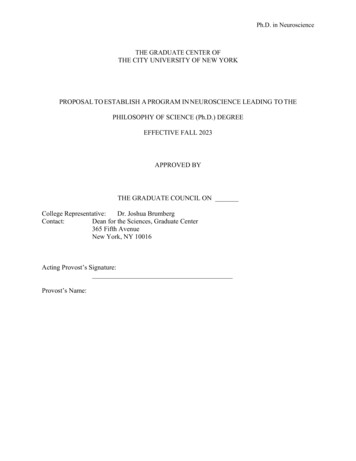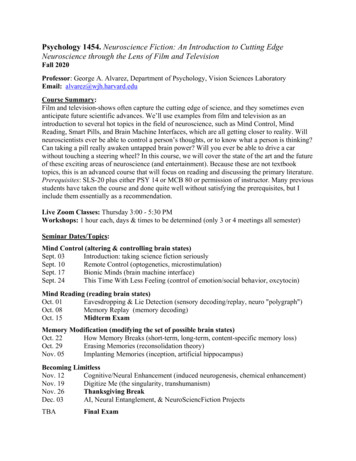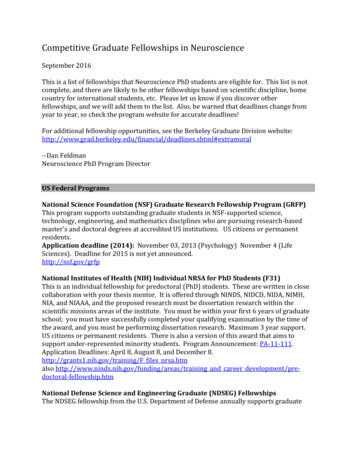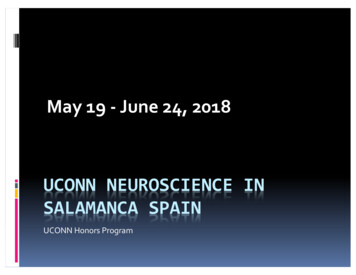
Transcription
Articles in PresS. J Neurophysiol (October 4, 2017). doi:10.1152/jn.00582.20171Case Studies in Neuroscience:2A Dissociation of Balance and Posture Demonstrated by3Camptocormia4R.J. St George1, V.S. Gurfinkel2, J Kraakevik2, J.G. Nutt2 and F.B. Horak2,3516Sensorimotor Neuroscience and Ageing, School of Medicine, University of Tasmania,78Australia.2Department of Neurology, Oregon Health & Science University, Portland, Oregon, USA.3910VA Health Care System, Portland, Oregon, USA.Author contributions:11Conceived and designed research: RJStG, VSG, JGN, FBH12Performed experiments: RJStG, VSG, JK, FBH13Analyzed data: RJStG, VSG14Interpreted results of experiments: RJStG, VSG, JGN, FBH15Prepared figures: RJStG16Drafted manuscript: RJStG, VSG17Edited and revised manuscript: RJStG, VSG, JK, JGN, FBH18Approved final version of manuscript: RJStG, VSG, JK, JGN, FBH19Running head: Balance and Posture in Camptocormia20Correspondence to:Dr. Rebecca J St George21Email: rebecca.stgeorge@utas.edu.au22Address: Sensorimotor Neuroscience and Ageing Laboratory, School23of Medicine, Faculty of Health, University of Tasmania, Private Bag 30,24Hobart, TAS, 7001, Australia.251Copyright 2017 by the American Physiological Society.
26Abstract27Upright stance in humans requires an intricate exchange between the neural mechanisms that28control balance and those that control posture; however, the distinction between these control29systems is hard to discern in healthy subjects. By studying balance and postural control of a30participant with camptocormia – an involuntary flexion of the trunk during standing that31resolves when supine – a divergence between balance and postural control was revealed. A32kinematic and kinetic investigation of standing and walking showed a stereotyped flexion of33the upper body by almost 80 degrees over a few minutes, and yet the participant’s ability to34control their center of mass within their base of support and to compensate for external35perturbations remained intact.36This unique case also revealed the involvement of automatic, tonic control of the paraspinal37muscles during standing and the effects of attention. Although strength was reduced and MRI38showed a reduction in muscle mass, there was sufficient strength to maintain an upright39posture under voluntary control and when using geste antagoniste maneuvers or “sensory40tricks” from visual, auditory and haptic biofeedback. Dual-tasks that either increased or41decreased the attention given to postural alignment would decrease, or increase the postural42flexion, respectively. The custom-made, ‘twister’ device that measured axial resistance to43slow passive rotation revealed abnormalities in axial muscle tone distribution during44standing. The results suggest that the disorder in this case was due to a disruption in the45automatic, tonic drive to the postural muscles and myogenic changes were secondary.462
47New & Noteworthy48By studying an idiopathic camptocormia case with a detailed biomechanical and49sensorimotor approach, we have demonstrated unique insights into the neural control of50human bipedalism i) balance and postural control cannot be considered the same neural51process, as there is a stereotyped abnormal flexed posture, without balance deficits,52associated with camptocormia, and ii) posture during standing is controlled by automatic53axial tone but ‘sensory tricks’ involving sensory biofeedback to direct voluntary attention to54postural alignment can override, when required.5556Keywords: Camptocormia, Balance, Posture, Standing, Axial Tone3
57Introduction58Terms such as ‘postural control’ and ‘balance’ are often used interchangeably in literature on59human stance, but equating these control systems is misleading. Upright stance actually60requires two different actions: i. posture, that is maintaining alignment of the body segments61with respect to each other and to external references (gravitational vertical, visual vertical, or62the support surface), and ii. balance, that is the ability to avoid falling in both static (e.g. quiet63standing) and dynamic situations (e.g. walking, external perturbations).64To maintain normal standing, the mechanisms of posture and balance are closely65interdependent so it is easy to see why they may be considered a single process. The balance66system may need to respond to a change of body alignment and conversely, changes in body67alignment may occur in anticipation of, or following, a threat to balance. Despite this intimate68relationship, the mechanisms by which the central nervous system controls balance and69posture during standing may be different so it is unclear whether abnormal control of posture70necessarily impairs control of balance.7172Camptocormia is a rare condition characterized by an involuntary forward flexion of the73trunk that is present in standing and walking, but resolves when supine. Although postural74alignment is impaired in this condition, it is unknown to what extent balance is also affected.75A previous study has shown that when healthy subjects voluntarily assume a flexed posture76they are more unstable when perturbed (Jacobs et al. 2005). In the current study, the flexed77posture is the preferred posture, so the balance responses may be adapted to this position, or78they may show similar impairment. As balance control during quiet stance may not reflect79the control during perturbations and movement, different domains of balance control need to80be evaluated.4
81The pathogenesis of camptocormia can generally be divided into two camps: a disorder that82causes weakness in extensor postural muscles (Laroche et al. 1995; Mahjneh et al. 2002;83Margraf et al. 2010) or a central dystonic disorder that disrupts axial postural tone (Reichel et84al. 2001; Slawek et al. 2003; Azher and Jankovic 2005; Melamed and Djaldetti 2006).85Muscle fibers can be activated through either voluntary motor drive that requires conscious86attention to achieve a particular goal, or through automatic tonic drive. Tonic drive is an87unconscious process, whereby continuous nerve impulses activate the muscle to keep it in a88partially contracted state. When humans stand upright, tonic drive is automatically increased89in antigravity muscles to keep them extended in response to the low-intensity stretch from90gravity. Voluntary drive has strong cortical projections, whereas muscle tone is derived from91a number of subcortical structures, most notably the basal ganglia and brainstem (Takakusaki92et al. 2003). Therefore, measuring the force generated from maximal voluntary contractions93or muscle imaging does not reveal the extent to which automatic, tonic control of muscles94used for postural alignment in stance is disturbed. Quantifying axial postural tone is95traditionally problematic, however, our unique “twister” device (Gurfinkel et al. 2006)96allowed us to measure, for the first time, automatic axial hip and trunk tone in a97camptocormia subject during stance. We also manipulated the relative amount of voluntary98versus automatic control to postural alignment with a dual task to divert attention or with99sensory biofeedback (‘sensory tricks’) to add a voluntary postural goal.100101Case history102The subject was an active and independent 81 year old female with a twenty-year history of103camptocormia. She reported a sudden onset of her flexed posture that occurred while she was104hiking. Her posture was severely flexed forward when standing and walking (Figure 1A) but105straight when supine (Figure 1C). She maintained an erect posture when using a rolling5
106walker (Figure 1B), but at home, she preferred the flexed posture to avoid using a walker.107Ascending a staircase was performed “on all fours”. She slept comfortably on either her back108or side. She had some intermittent lumbosacral pain but there was no evidence of stroke; no109parkinsonian signs of bradykinesia, rigidity, or tremor; no mental status abnormalities and110deep tendon reflexes were intact. MRI of the brain was unremarkable. MRI of the lumbar and111thoracic spine indicated no structural problems, but the para-spinal (multifidus and112longissimus) muscles showed some fatty infiltration (Figure 1D). The iliopsoas muscles by113comparison looked normal. Therapeutic strategies had been ineffectual, including; levodopa,114trihexphenidyl, baclofen, and botulinum toxin A injections to the rectus abdominis and psoas115muscles.116117[Figure 1]118Methods & Results119Signed consent was obtained and the OHSU Institutional review board had approved all120experimental procedures. A healthy subject that matched the camptocormia subject by age,121gender, height and weight was used as a control in some conditions.122123Posture versus Balance124The transition from the upright to the flexed posture occurred over 2-3 minutes with a125stereotyped time course when measured in 3 sessions over 6 months (exponential time126constant of 32 1.2s, Figure 2A). To maintain equilibrium during quiet standing, the nervous127system must maintain the vertical projection of the position of the body’s center of mass128(CoM) over the base of support (the feet). The CoM represents the unique point where the129weighted relative position of the distributed mass sums to zero. CoM position and segmental130alignment were calculated from 29 reflective markers placed on body landmarks, sampling at6
13160 Hz (Motion Analysis, Santa Rosa, CA). An inertial sensor placed on the cervical spine,132sampling at 50 Hz (Xsens, Enschede, The Netherlands) measured trunk tilt with respect to133gravity and force plates measured ground reactive forces at 480Hz.134135The flexion did not simply involve the trunk (as implied by the “cormia”/trunk) rather, all136axial segments underwent a change in alignment (Figure 2A). Flexion of the trunk and hips137was accompanied by extension of the knee and ankle, acting to move the pelvis backward and138thus stabilize balance. The overall effect was maintenance of the center of pressure (CoP) and139the position of the CoM in the horizontal plane over the base of support (Figure 2B). The140back extensor EMG increased as the trunk tilted off vertical and was maintained over the141early phase of the forward trunk flexion. However, the muscle activity reduced and became142relatively quiet after approximately 40 degrees of trunk flexion (Figure 2C).143144[Figure 2]145146Balance response latencies of the CoP in responding to unexpected forward (mean S.D.147122 9ms) and backwards (115 12ms) translations of the standing surface were normal148relative to age-matched control subjects (Nashner 1993). In addition, postural sway measured149from peak-to-peak displacement of the CoP was normal on all six items of the Neurocom150Sensory Organization Test when standing; i) eyes open, ii) eyes closed, iii) sway referenced151to visual field, iv) sway referenced to the standing surface, v) sway referenced to the standing152surface without vision, vi) sway referenced to both the visual field and support surface. This153demonstrates normal integration of visual, vestibular and proprioceptive input for balance.154Also, postural responses elicited by vibrotactile stimulation (80Hz) of the bilateral achilles7
155tendons for 10 seconds resulted in, a transient forward CoP displacement (30 3mm),156consistent with normal responses (Thompson et al. 2007).157158To determine whether the deficit in postural alignment was due to a problem with a sense of159verticality, as is often seen in PD (Vaugoyeau et al. 2010) or following brainstem (Yang et al.1602014) or hemispheric stroke (Perennou et al. 2008), the tilt of a hand-held rod with respect to161gravity was recorded while subjects were blindfolded for 3 minutes (Wright and Horak1622007). The rod was held near to vertical ( 1degree) even while the body flexed forward,163indicating a normal sense of verticality.164165Voluntary versus Automatic Postural Control166The camptocormia subject had sufficient strength to rise from sitting to standing without the167use of her arms. Furthermore, on the experimenter’s command, the subject was able to extend168her body to the upright (Figure 2C). Maximum isometric strength in the trunk flexors and169extensors was measured from a seated position with a dynamometer (Ametek MSC Series)170attached with a strap under the arms. The dynamometer was attached to a fixed support in171front, and then behind the subject to measure trunk extensor and flexor strength respectively.172Three measurements were made with a rest period of 1 minute between each attempt and the173average torque was calculated and normalized to body weight and height. Peak isometric174trunk extension about the hip joint center was 4.16 0.36Nm and flexion force was1754.04 0.19Nm, which was 48% and 77% respectively of normal adult female strength (Keller176and Roy 2002).177178“Sensory Tricks”: While standing, the subject performed dual-tasks that either increased or179decreased the attention given to postural alignment. Increasing attention to posture was8
180achieved in three ways: i) audio-biofeedback with a tone that increased in pitch and volume181with forward sagittal tilt of the trunk measured with an inertial sensor; ii) visual biofeedback182of the trunk angle in space was visually presented on a 2-D scale on a screen held in front of183the subject; iii) aiming a laser attached to a toy pistol to a circular target located 3m away184from the subject at shoulder height. The subject was given no instruction other than to keep185the laser pointed on the target, however, the task was easier with an upright posture. The186attention of the subject was diverted away from postural alignment by counting backwards by187threes from a random number between 100 and 200.188189The subject was able to maintain an upright posture for over 3 minutes during both the visual190and the auditory biofeedback tasks (Figure 3A). When the dual-task was to aim a laser pistol191on a target, there was some forward tilt of the trunk relative to space but the amplitude of the192flexion over the same time scale was reduced by half (32º versus 65º). However, when193attention was diverted by a serial subtraction dual-task, the rate of trunk bending occurred at a194faster rate than quiet standing (time constants 22s versus 32s respectively).195196Walking: When the camptocormia subject walked forward, the rate of forward flexion of the197trunk was similar to flexion during quiet stance with eyes open (time constant 36 s) (Figure1983Biii). In contrast, during backward and sideways walking, the tilt of the trunk had no199significant flexion over 3 minutes. Both backward and sideways walking were associated200with backward extension of the arms at the shoulders, the “backswept wing” sign (Margraf et201al. 2016), which may have helped to limit forward motion of the trunk. Forward locomotion202is suggested to be more automatic, unlike less habitual walking styles that require greater203voluntary cortical control (Hackney and Earhart 2010).2049
205[Figure 3]206207Axial tone: To measure axial tone during upright stance on the “twister” device the support208surface slowly oscillated in the horizontal yaw plane with a triangle waveform back and209forward at 1 deg/s over an amplitude of 5 degrees (Gurfinkel et al. 2006). The resistance to210twisting between the lower body and upper body was measured by affixing either the pelvis211(to measure hip tone) or the shoulders (to measure both trunk and hip tone) to an earth-fixed-212rigid frame. The peak resistance to the rotation was recorded over 5 continuous waveforms213and an average was taken. The torsional resistance measured with this technique is a214combination of the tone in both axial flexors and extensors.215The camptocormia subject had higher hip torque than the age, sex, and BMI matched control216subject by 11.4% (1.85 0.08 versus 1.66 0.01 Nm), and lower trunk torque by 42%217(1.58 0.09 versus 2.71 0.01 Nm). The ratio of the higher trunk tone relative to the hips seen218in the healthy subject is consistent with our previous studies of healthy control subjects219(Wright et al. 2007). However this ratio of axial tone distribution was markedly disturbed in220the camptocormia subject.221222223DiscussionThis first biomechanical investigation into camptocormia has exposed some important224insights into neural control of human standing. Despite severe impairment of postural225alignment during standing and forward walking, balance control mechanisms were shown to226be intact. This unique case strikingly underscores the fact that “postural control” is not227“balance”.228229Previous research on camptocormia has only focused on the terminal, abnormal trunkposition. In this study, we have observed the stereotyped transition from the upright to the10
230flexed posture, with a time constant of 32 seconds. The rate of forward trunk flexion was231found to be consistent over three testing sessions months apart. This observation plus the232observation that attention to posture influenced the degree of flexion indicates the difficulty233with categorizing camptocormia by the angle of flexion (Margraf et al. 2016;234Srivanitchapoom and Hallett 2016). The changes in alignment between body segments were235highly correlated; with the forward flexion of the trunk and hips counterbalanced by the236extension of the knee and ankle joint, acting to move the pelvis backward to maintain the237projection of the body CoM over the base of support. Babinski (1899) described similar body238compensation during fast voluntary bending in healthy subjects - the ‘Babinski synergy’ that239was absent in people with cerebellar lesions. The dynamic relationship among the axial240segments seen in camptocormia is consistent with a functional Babinski muscle synergy. To241enact such a balance synergy, the central nervous system must integrate sensory input242regarding joint angles with knowledge of segment lengths and mass distributions, which243comes from the areas of the brain that store body schema representations (Holmes and244Spence 2004).245The subject also had normal balance reactions to visual, vestibular and vibrotactile246stimuli, as well as to perturbations of the standing surface. Together, these results247demonstrate that the subject had excellent balance control which is substantiated by the fact248that she did not report falling and led an active, independent lifestyle.249The pathogenesis of camptocormia is complex and controversial. The subject had250reduced muscle mass and relative weakness of the trunk extensors. Based on similar251evidence, others have concluded that the primary cause of camptocormia is myogenic252(Margraf et al. 2010; Devic et al. 2012; Renard et al. 2012). However, secondary effects253associated with reduced use of spinal extensors could produce similar findings. In fact, as254normal people age, it is common to see fatty replacement of para-spinal muscles (Haig et al.11
2552006) and biopsy shows increased pathological abnormalities (Pearce 2005). Furthermore,256prolonged passive stretching of lower back extensor muscles in static flexion may cause257viscoelastic elongation of the muscles which reduces their force generating capacity (Shin et258al. 2009).259Before a causal link is drawn between loss of muscle mass and primary muscle260pathology, biomechanical principles of standing posture must be considered. Upright posture261during normal standing is the equilibrium point of competing forces on the body. To maintain262upright standing, the tonic control of the dorsal muscles of the trunk and hips must counteract263both the static forward moment of gravity and flexor tone. However, only relatively small264extensor forces are needed to keep the torso erect. Experimental and biomechanical modeling265work (Cholewicki et al. 1997; Kiefer et al. 1998) shows that less than 5% of the trunk266extensor MVC is used for upright standing and walking. A slightly larger percentage of the267MVC would be required in this camptocormia case, given the absolute MVC is reduced for268the same body mass (8.3% of the MVC). This suggests that even though the back extensors269showed some weakness, our camptocormia subject still had sufficient strength to maintain270upright posture - which she did, but only when posture was under voluntary control with271“sensory tricks”.272The ability to voluntarily generate muscle contractions that are sufficient for upright273body stabilization have been reported in other severe cases of camptocormia (Lin 2004).274When our subject performed dual-tasks that directed her attention toward her posture, body275alignment could be maintained near to vertical. In contrast, by distracting attention away276from her posture, the rate of forward flexion increased compared to quiet standing. If the277disorder had a psychogenic origin the rate of flexion would be expected to decrease, not278increase, with distraction.12
279We propose that geste antagoniste maneuvers, or “sensory tricks” over-ride failing tonogenic280pathways either with voluntary cortical commands, or via augmented sensory inputs to281modulate postural muscle tone directly (Franzen et al. 2011). There are many reports of282camptocormia responding well to sensory tricks including: wearing a backpack (Gerton et al.2832010), touching a support (Azher and Jankovic 2005; Shinjo et al. 2008) and walking284backward (Van Gerpen and Van Gerpen 2006). We observed an improvement with each of285these “tricks” as well as some new ones - auditory and visual biofeedback. These features are286characteristic of dystonia. The ‘twister’ device showed the tonic activity of trunk and hip287muscles in the camptocormia subject was disturbed compared to normal subjects. The results,288considered in light of the physiological principles of standing, suggest a disruption in the289automatic, tonic control of axial muscles as the primary cause of our 3“Balance” and “postural control” should not be considered the same process and here is a294unique example demonstrating why this is so: a woman with idiopathic camptocormia who295had disrupted automatic, tonic control of posture during standing, had excellent balance. Her296balance synergies during trunk flexion, and responses to mechanical and sensory297perturbations, were all functionally normal despite her stereotyped, flexed posture.298299Grants300RJ St George is supported by the National Health and Medical Research Council of Australia301Early Career Fellowship (GNT1036234). FB Horak and J Nutt are supported by the National302Institutes of Health (AG0006457).30313
0Azher SN, Jankovic J. Camptocormia: pathogenesis, classification, and response to therapy.Neurology 65(3): 355-359, 2005.Babinski F. De l’asynergie cerebelleuse. Rev Neurol 7: 806–816, 1899.Cholewicki J, Panjabi MM, Khachatryan A. Stabilizing function of trunk flexor-extensormuscles around a neutral spine posture. Spine 22(19): 2207-2212, 1997.Devic P, Choumert A, Vukusic S, Confavreux C, Petiot P. Myopathic camptocormiaassociated with myasthenia gravis. Clin Neurol Neurosurg 19(12): 00593-00598, 2012.Franzen E, Gurfinkel VS, Wright WG, Cordo PJ, Horak FB. Haptic touch reduces swayby increasing axial tone. Neuroscience 174: 216-223, 2011.Gerton BK, Theeler B, Samii A. Backpack treatment for camptocormia. MovementDisorders 25(2): 247-248, 2010.Gurfinkel VS, Cacciatore TW, Cordo P, Horak F, Nutt J, Skoss R. Postural muscle tonein the body axis of healthy humans. J Neurophysiol 96(5): 2678-2687, 2006.Hackney ME, Earhart GM. The effects of a secondary task on forward and backwardwalking in Parkinson's disease. Neurorehabil Neural Repair 24(1): 97-106, 2010.Haig AJ, Tong HC, Kendall R. The bent spine syndrome: myopathy biomechanics symptoms. Spine Journal: Official Journal of the North American Spine Society 6(2): 190194, 2006.Holmes NP, Spence C. The body schema and the multisensory representation(s) ofperipersonal space. Cogn Process 5(2): 94-105, 2004.Jacobs JV, Dimitrova DM, Nutt JG, Horak FB. Can stooped posture explainmultidirectional postural instability in patients with Parkinson's disease? Experimental BrainResearch, 166(1): 78-88, 2005.Kiefer A, Shirazi-Adl A, Parnianpour M. Synergy of the human spine in neutral postures.Eur Spine J 7(6): 471-479, 1998.Laroche M, Delisle MB, Aziza R, Lagarrigue J, Mazieres B. Is camptocormia a primarymuscular disease? Spine 20(9): 1011-1016, 1995.Lin J. Camptocormia in Parkinson's Disease. Acta neurologica Taiwanica 13(1): 46-47,2004.Mahjneh I, Marconi G, Paetau A, Saarinen A, Salmi T, Somer H. Axial myopathy – anunrecognised entity. J Neurology 249(6): 730:734, 2002.14
Margraf N, Wrede A, Rohr A, Schulz-Schaeffer W, Raethjen J, Eymess A, Volkmann J,Mehdorn M, Jansen O, Deuschl G. Camptocormia in Idiopathic Parkinson's Disease: Afocal myopathy of the paravertebral muscles. Movement disorders Journal 25(5): 542-551,2010.Margraf NG, Wrede A, Deuschl G, Schulz-Schaeffer WJ. Pathophysiological Conceptsand Treatment of Camptocormia. J Parkinsons Dis 6(3): 485-501, 2016.Melamed E, Djaldetti R. Camptocormia in Parkinson's disease. J Neurol 253 Suppl 7:VII14-16, 2006.Nashner L. (1993). Computerized dynamic posturography. Chicago (IL), Mosby-Year Book.Pearce JM. A note on bent spines: 'camptocormia' and 'head ptosis'. Eur Neurol 53(2): 103105, 2005.Perennou DA, Mazibrada G, Chauvineau V, Greenwood R, Rothwell J, Gresty MA,Bronstein AM. Lateropulsion, pushing and verticality perception in hemisphere stroke: acausal relationship? Brain 131(Pt 9): 2401-2413, 2008.Reichel G, Kirchhofer U, Stenner A. Camptocormia--segmental dystonia. Proposal of anew definition for an old disease. Nervenarzt 72(4): 281-285, 2001.Renard D, Castelnovo G, Fernandez C, De Paula AM, Penttila S, Suominen T, Udd B.Camptocormia as presenting sign in myofibrillar myopathy. Neuromuscul Disord 22(11):987-989, 2012.Shin G, D'Souza C, Liu YH. Creep and fatigue development in the low back in staticflexion. Spine 34(17): 1873-1878, 2009.Shinjo S, Torres S, Radu A. Camptocormia: a rare axial myopathy. Clinics 63: 416-417,2008.Slawek J, Derejko M, Lass P. Camptocormia as a form of dystonia in Parkinson's disease.Eur J Neurol 10(1): 107-108, 2003.Srivanitchapoom P, Hallett M. Camptocormia in Parkinson's disease: definition,epidemiology, pathogenesis and treatment modalities. J Neurol Neurosurg Psychiatry 87(1):75-85, 2016.Takakusaki K, Habaguchi T, Ohtinata-Sugimoto J, Saitoh K, Sakamoto T. Basal gangliaefferents to the brainstem centers controlling postural muscle tone and locomotion: a newconcept for understanding motor disorders in basal ganglia dysfunction. Neuroscience119(1): 293-308, 2003.Thompson C, Belanger M, Fung J. Effects of bilateral Achilles tendon vibration on posturalorientation and balance during standing. Clin Neurophysiol 118(11): 2456-2467, 2007.Van Gerpen JA, Van Gerpen JA. Dopa-responsive dystonic camptocormia. Neurology66(11): 1779, 2006.15
yeau M, Azulay JP. Role of sensory information in the control of postural orientationin Parkinson's disease. Journal of the Neurological Sciences 289(1-2): 66-68, 2010.Wright WG, Gurfinkel VS, Nutt J, Horak FB, Cordo PJ. Axial hypertonicity inParkinson's disease: direct measurements of trunk and hip torque. Exp Neurol 208(1): 38-46,2007.Wright WG Horak FB. Interaction of posture and conscious perception of gravitationalvertical and surface horizontal. Exp Brain Res 182(3): 321-332, 2007.Yang TH, Oh SY, Kwak K, Lee JM, Shin BS, Jeong SK. Topology of brainstem lesionsassociated with subjective visual vertical tilt. Neurology 82(22): 1968-1975, 2014.16
416Figure Captions417418419420Figure 1. The camptocormia subject’s preferred posture (A), walking with a rolling walker (B), lying421supine (C), and MRI (T1 weighted) of the spine with the arrows indicating fatty replacement of the422para-spinal muscles (D).42317
424425426427Figure 2. Quiet stance immediately following rising from a chair. A. Postural alignment. The upper428graph shows the tilt of the body recorded from C3 with respect to gravity on three trials, each over one429month apart. The lower graph shows the mean change in sagittal angle of separate body segments.430The ankle angle was defined by the knee, ankle and metatarsal markers; the knee angle from the431greater trochanter, knee and ankle markers; the trunk from the C3,T10 and PSIS; and the neck angle432from the ear, C3 and T10 markers. The pelvis angle was defined by the angle between the ASIS and433PSIS vector and the knee to greater trochanter vector. B. Static balance control. CoP (x,y plane) and434CoM (x,y plane) remained stable over time, while CoM in the vertical (z) direction moved closer to the435ground. C. Para-spinal EMG and trunk tilt. The camptocormia subject was instructed to “stand436straight” after 120s. Paraspinal EMG activity was sampled at 480 Hz, amplified at a gain of 5–10K,437band-pass filtered from 75–2000 Hz, and full-wave rectified.43818
439440Figure 3. Modulating the amount of voluntary control to postural muscles. All graphs show the tilt of441the upper trunk (C3) relative to gravity. A. Erect posture was better controlled during dual-tasks that442required an upright alignment to perform the task (visual/audio biofeedback and a pistol aiming task),443whereas during the counting backwards task postural alignment degraded more rapidly compared444with normal quiet standing. B. Mean ( S.D.) changes to the trunk alignment during
52 associated with camptocormia, and . ii) posture during standing is controlled by automatic 53 axial tone but 'sensory tricks' involving sensory biofeedback to direct voluntary attention to 54 postural alignment can override, when required. 55 56 . Keywords: Camptocormia, Balance, Posture, Standing, Axial Tone

